Early “Steam Men” Illustrations
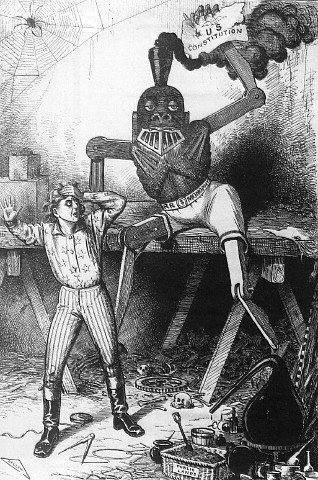
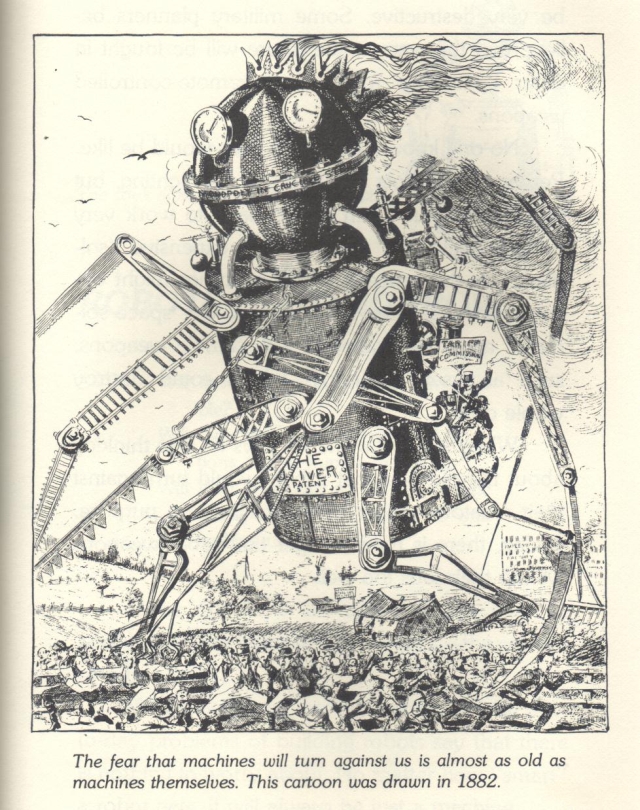
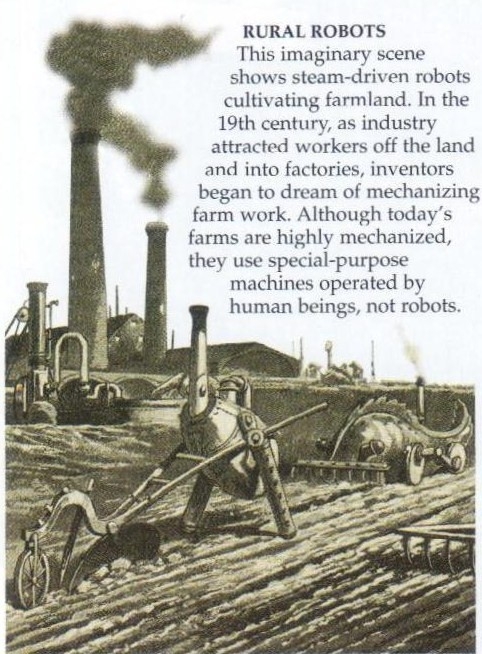
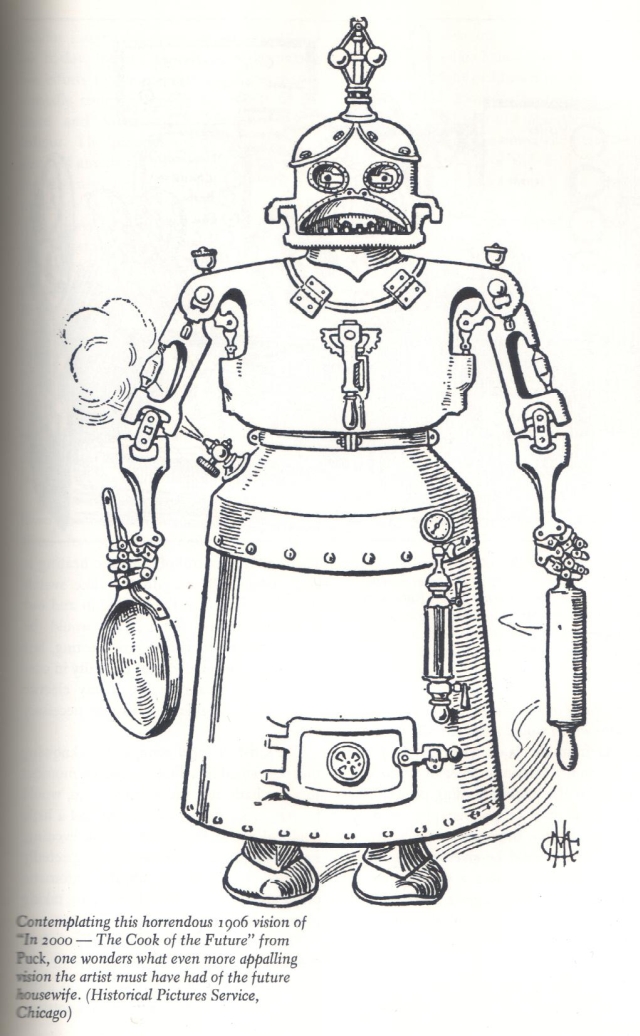

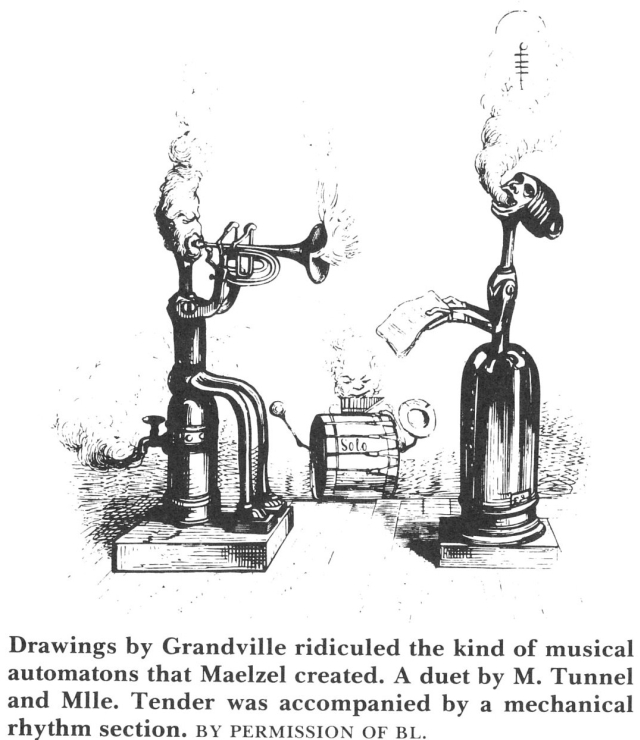
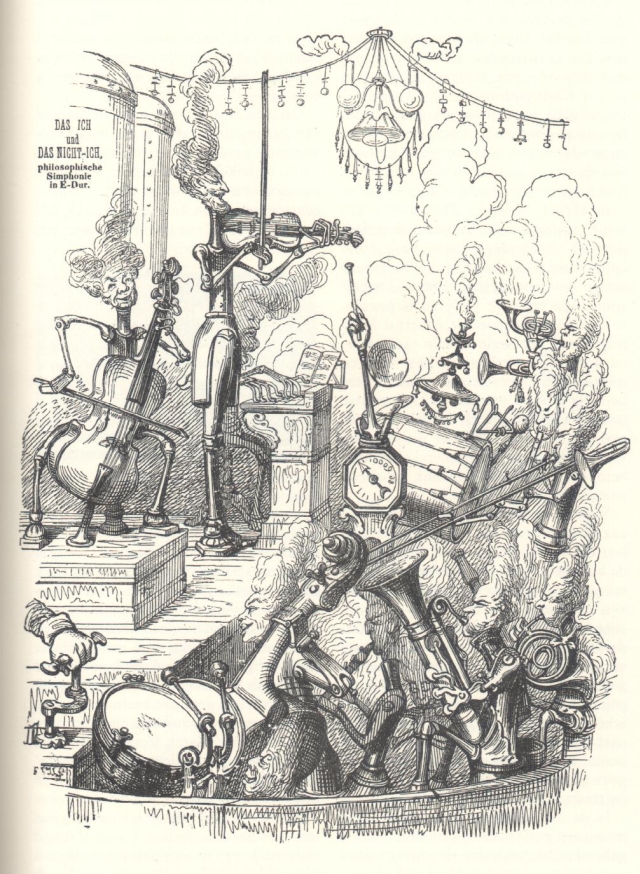
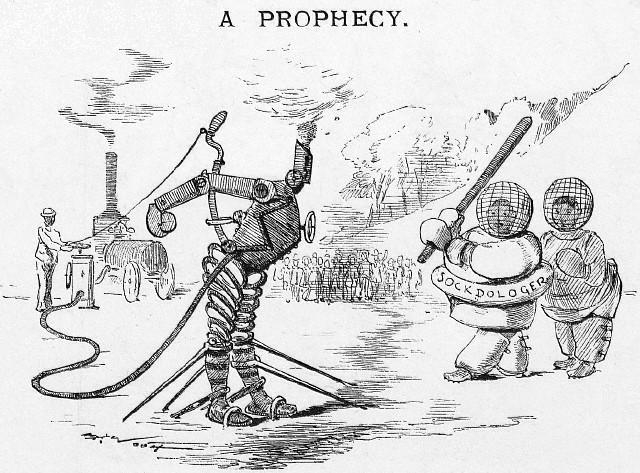
A Steam-driven baseball pitcher.
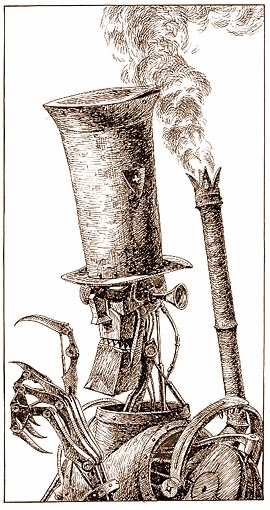
Modern Steam Punk illustration.
a history of cybernetic animals and early robots








A Steam-driven baseball pitcher.

Modern Steam Punk illustration.
When I first saw information on Scherman's Steam Man (2004), there was very little information about him. Scherman worked for Disney, and was the definitive person on Disney's Nautilus. His concept for a steam man is amazing.
A Vernian enthusiast posted some images (flickr) found in Scherman's friend Kendall roundhouse., also showing a pin-up board of his inspiration, Reade's Fictional Steam Man of the Prairies 1868 (not 1841 or 1892 as read in the images [although 1892 might be a re-issue date]).
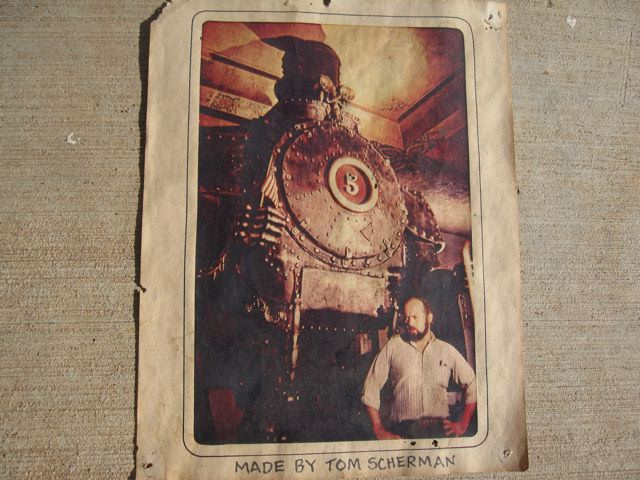
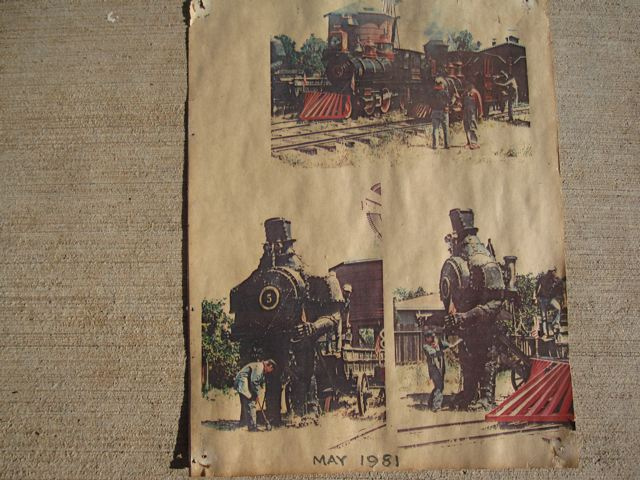
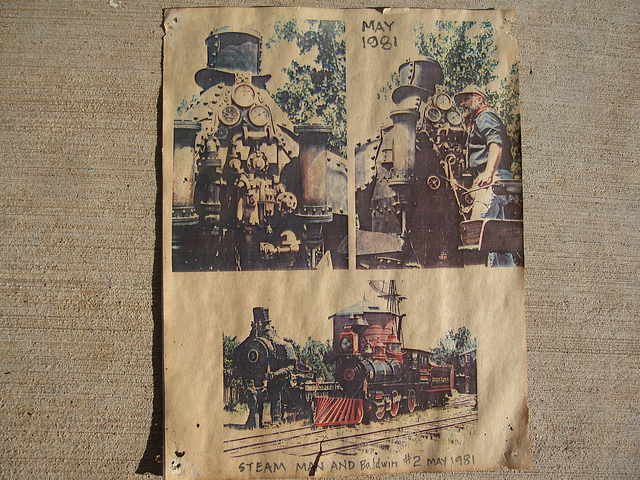
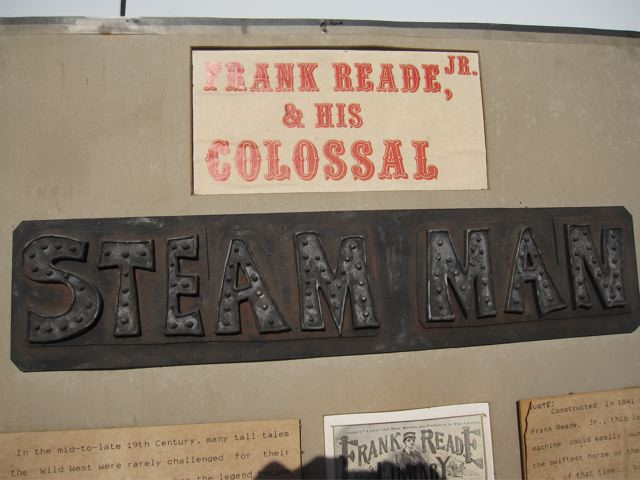
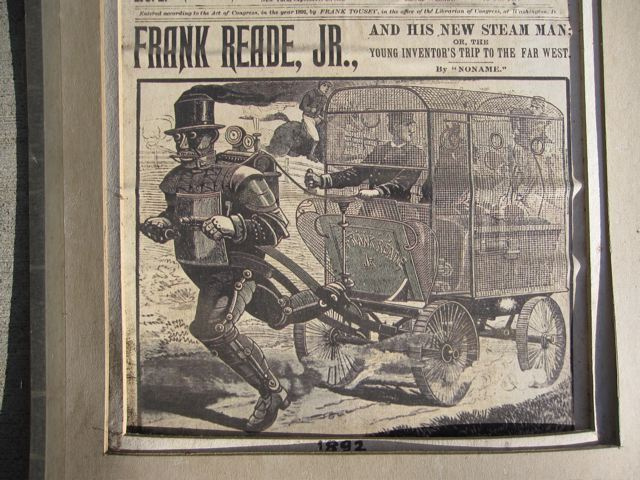
A more recent article suggests that the Steam Man, referred to as the Iron Man, was proposed to Disney for a TV series around Nemo and Nautilus 2 (that Scherman had modelled). The Iron Man was to cart supplies around Vulcania.
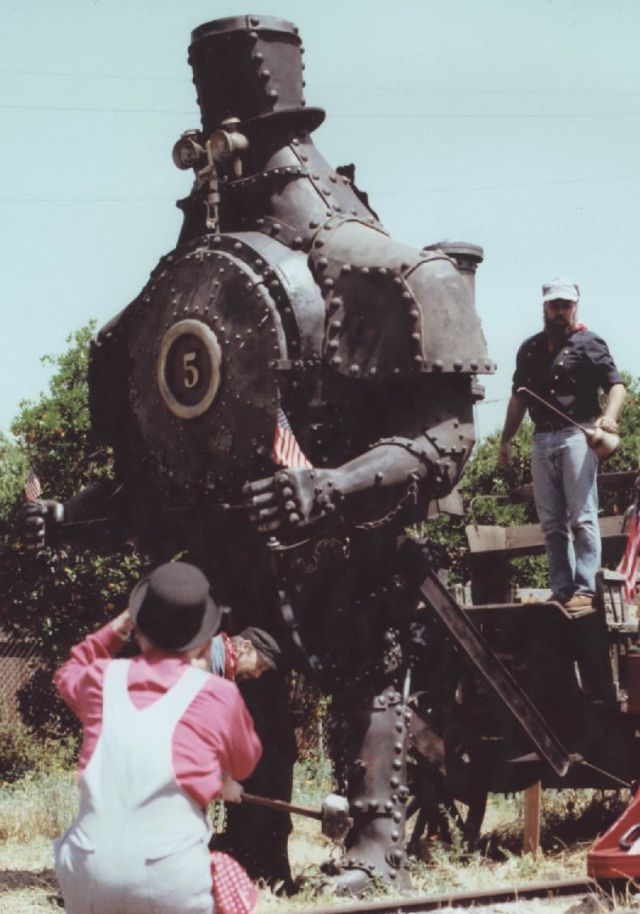
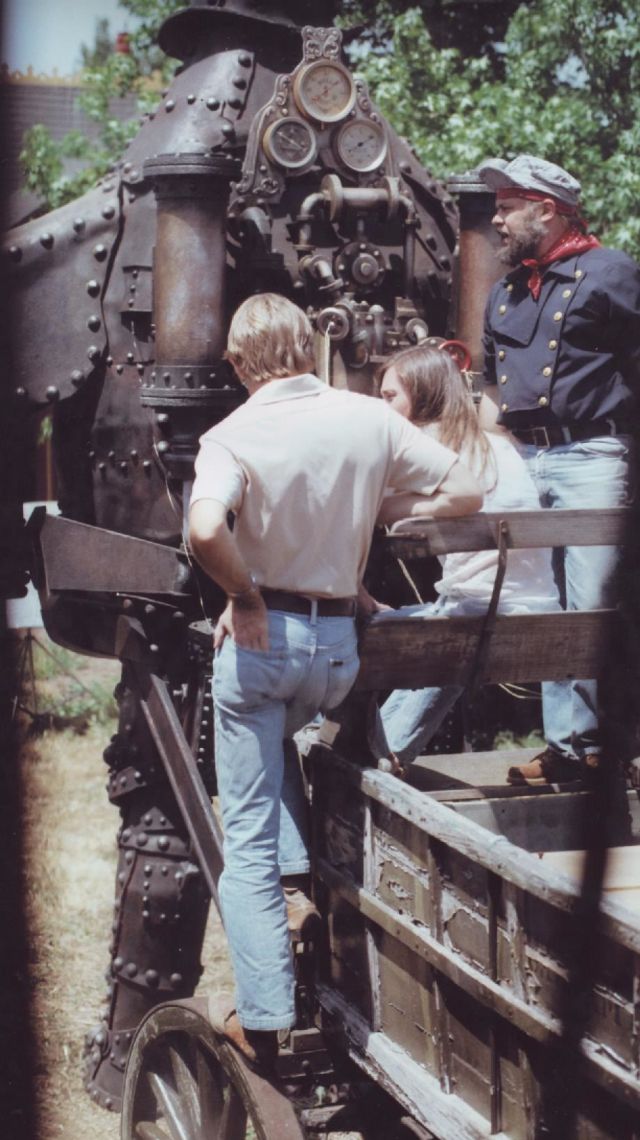
Above 2 photographs property of John Patrick Burke (as per article).
For the full article and other wonderful articles around Scherman, see here.
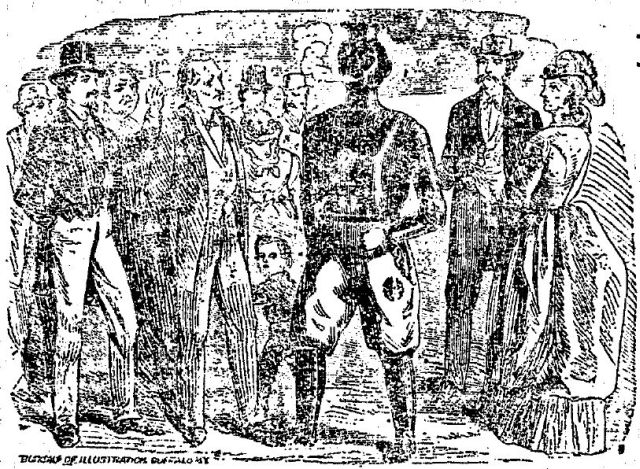
$7,000 Mechanical Wonder !
The only Steam Man
Actually walks and runs alone! The Greatest Invention of Modern Times.
The W.W. Cole's Great New York and New Orleans Zoological and Equestrian Exposition toured the American continent between 1871 and 1886, and in 1875 and early 1876 featured a Steam Man. Other than the illustration that appears in the newspapers of the time (see above), there is little information currently discovered on this Steam Man. Was it Dederick's old Steam Man, Morrison's Steam Man, Winans-Eno Steam Man, C.C. Roe's Steam Man, a copy of one of these, or a totally new Steam Man?
Dederick's Steam Man had its first outing in January, 1868 and was possibly last reported on in September 1869 when a Steam Man was for sale!
Morrison's Steam Man seems to be only exhibited in 1870. A later article says that the Steam Man was connected to a buggy, so probably not Morrison's.
Winans-Eno "Steam King" was on show in 1869, then was retained by Joseph Eno and later by his son, Alfred until at least 1906.
C.C. Roe's Steam Man was on show 1874, then in 1878.
Unfortunately we don't yet know how accurate the image of this Steam Man is. Dederick's Steam Man was almost 8ft tall, Roe's was 5ft tall. Morrison's walked stand-alone without pushing or pulling a cart or carriage. Later Steam Men were also fired by oil or gasline, not coal. Winans-Eno Steam Man (6ft 9in) was converted from a coal fired steam generator. Dederick's Steam Man caught fire possibly because it was coal fired. Roe's Steam Man shows smoke coming out of its hat / smoke stack, but its steam generator was not located within its body!
The Burlington Weekly HawkEye 29 Apr 1875 p5
The Great New York and New Orleans
Zoological and Equestrian Exposition.………….
The new invention, that will astonish
everybody, is the Steam Man. Walks
and runs alone, unsupported. A mechanical
marvel.
………………….
One of the first circuses known to have visited Burlington, when it was still known as Company Shops, was William W. Cole’s Circus. It appeared on Thursday, Oct. 21, 1875, and its featured attraction that year was a “steam man,” described as the “greatest invention of modern times” and costing $7,000. It is suspected that most people were disappointed when they saw the steam man because “he” didn’t resemble the illustration in the circus’ advertising at all. In fact, “he” was nothing but a steam boiler attached to the front of a buggy and disguised as a man." [Newspaper source: unknown]
In 1876, America held its Centennial in Philadelphia. There appears to have been four Steam Men built for the Centennial Exhibition, along with a Mechanical Horse.
An American inventor by the name of William Farr Goodwin, had some of his agricultural inventions produced by manufacturers who exhibited at the Centennial Exhibition, The National Iron Works, for example. We know that Goodwin also patented ideas for a scaleable toy Mechanical Horse (1867) and also a Walking Toy (1868). It is quite probable that the Goodwin design of his Mechanical Horse was used by The National Iron Works in their Mechanical Horse.
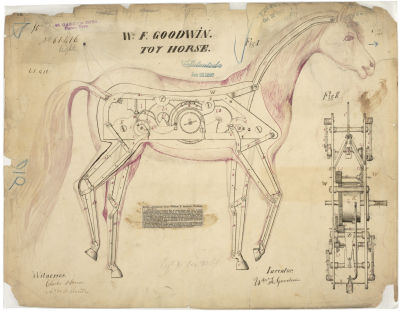
Iron – June 3, 1876, London, Middlesex
Mechanical horses and Men.- A mechanical horse is being made at the National Ironworks, New Brunswick, New Jersey, which is quite a curiosity in its way, and is to be on exhibition at the Centennial. The life-size model has been operated satisfactorily to all who have seen it. Every movement of the horse is as natural as life. It walks, and each joint of the leg is put in its proper motion, while the neck and head bob in appropriate unison, and yet the simplest mechanism is used, being nothing more than a few pulleys and one or two belts, the latter corresponding with the tendons of the natural animals. There are also four steam men being manufactured at Munn's machine shop. These men are for exhibition at the Centennial.
Update 26 July 2010: Located article from the Daily Times, New Brunswick, N.J., which confirms Goodwin as the inventor of the Centennial Steam Men and Mechanical Horse.
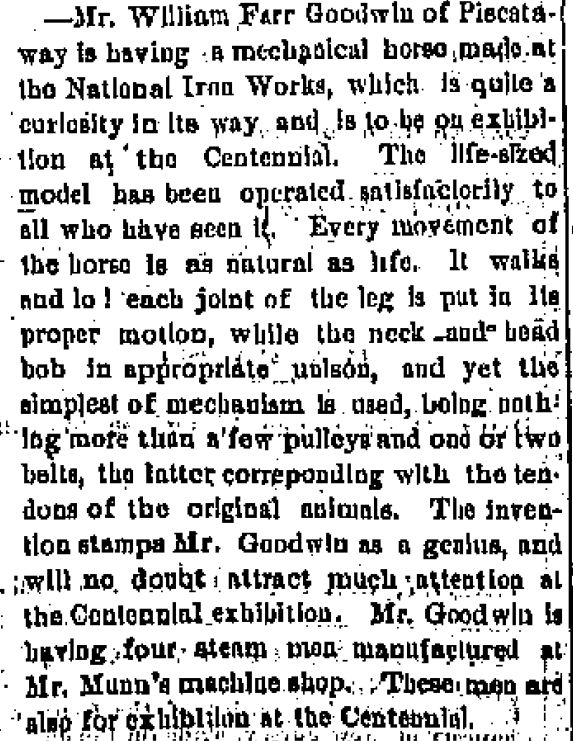
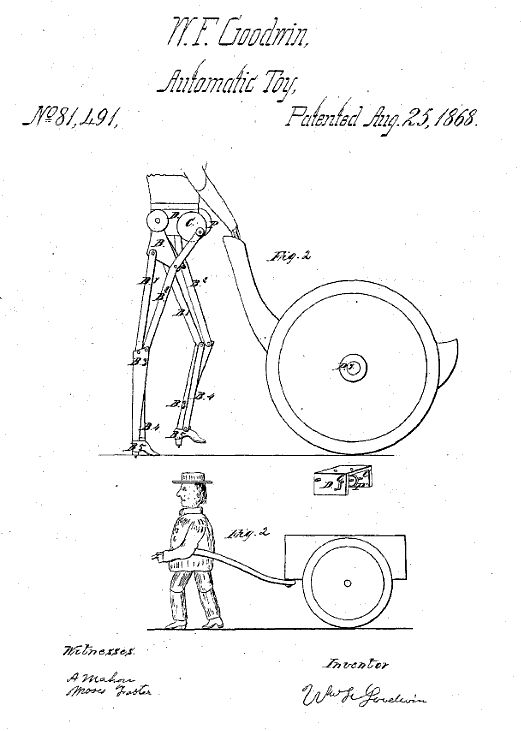
Evening Post, Volume XIV, Issue 79, 30 September 1876, Page 1
STEAM MAN AND A MECHANICAL HORSE.
Anglo-Australian writes in the European Mail : — "The Yankees are notably clever in the invention of machinery intended to subvert the use of manual labor. The last achievement in this direction is a mechanical horse and a steam man, which it is said are on view at the Centennial Exhibition. Their uses are not stated, but it is said that they are simple in construction, and very satisfactory in their movements. If they can be utilised in agricultural work, or in field labor generally, the inventor may expect a brisk demand for them in countries where labor is scarce. It would be too much to expect that the steam man could be trained to do the duties of a policeman, a waiter, or a member of any local house of assembly, because it may be assumed that he could not tell us that he was 'coming,' give evidence, or make windy speeches for the sake of obstructing business. Still, it may be assumed that he would be a very useful member of society if any one should have the courage to import him, just to see what he is like, and j what he can do. It would certainly be in his favor that he might be expected of him not to strike — except when the iron was hot — and the staunchest unionist could hardly object to work with him on the ground that he was not a society man. Indeed, from this point of view, he would be essentially a non-unionist, because it may be assumed that he was called into existence by the fact that the Union men were getting so well paid they could afford to do with eight hours' work a day. The iron man, therefore, may be regarded as the very essence of competition, and by-and-by he will be so improved upon that capitalists will be sure to give him the preference, and then your Union men will discover that they reckoned without their host when they conceived they could conserve to themselves a life of ease and independence upon eight hours' work a day."
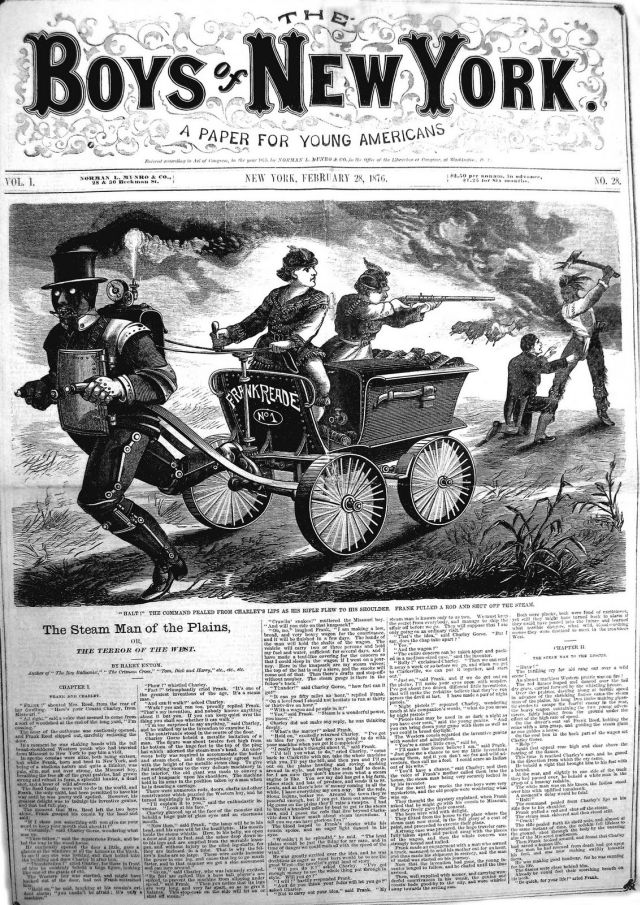
Brooklyn NY Daily Eagle 1923 p11
"Noname" Talks About Himself
"The use of the word 'Noname' was suggested by the late Frank Tousey. It was first used by Dr. Harry Enton of Brooklyn, an old friend of mine, who wrote for Tousey the "Steam Man of the Plains.' When he tired of the adventures of the steam man, who was a mechanical marvel who drew an Iron wagon across the world, protecting the young hero from all dangers, Tousey asked me to write a similar series, using electricity as a basis.
"Enton got his idea for the steam man, who was hideous looking, and all powerful steam propelled iron figure, from a steam-man who was exhibited at the Centennlal Exposition in 1876. Enton saw the steam man standing in front of a store on Center St., and built a series of storie about his exploits over the plains of the West and the deserts of Africa and Asia, where boys in search of treasure could by the steam man's aid strike terror to the natives and have adventures aplenty."["Noname" in this article is Lu Senarens.]
The original 1868 Steam Man of the Prairies Dime novel by Ellis was inspired by Dederick's and Grass' Steam Man, so the Centennial Steam Man is the inspiration to the second generation Steam Man of the Dime novels.
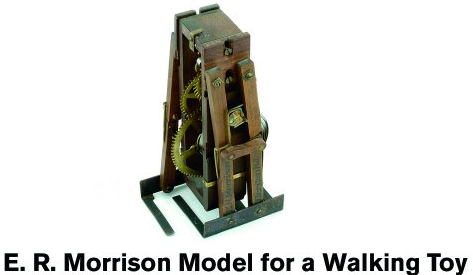
This wood and brass model with clockwork by Enoch Rice Morrison is a walking mechanism probably very similar to his “Steam Man”. The maker’s name is painted on an upright as is his home town – Bergen, NJ The model is 6.5″ tall. I have now located the patent for this mechanism – see below.
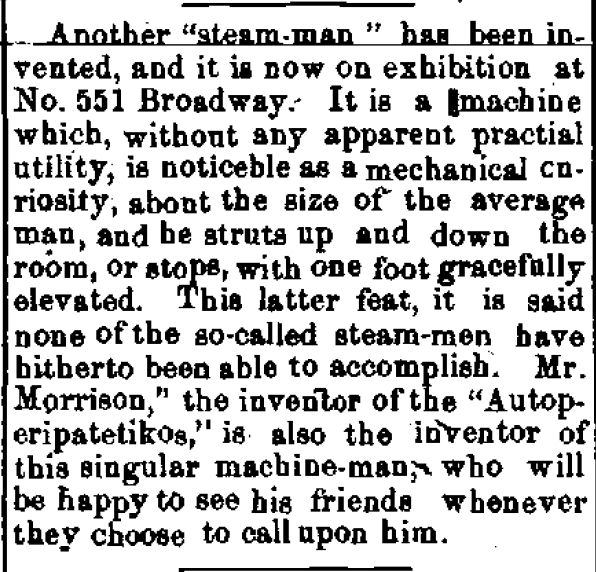
Tuapeka Times, Volume III, Issue 134, 1 September 1870, Page 7.
GENERAL NEWS.
There is now on exhibition in New York a ” steam man ” which actually walks — not merely performs with the legs the movements necessary for walking, while the body is suspended on a fixed support like the old ” steam man” which made so much noise about two years ago [RH – Dederick 1868], and which, we suppose, is now defunct. It was claimed for the old steam man that it was to be used for traction and other useful purposes ; but the new one commences its career with no such pretensions. All that is claimed for it is that it makes an interesting exhibition. It has the same walking mechanism as the clockwork walking dolls patented some years ago [CZ: Morrison’s 1861 “Locomotive Apparatus”, not the 1862 “Autoperipatetikos”]. The mechanism is driven by one of Behren’s rotary steam engines, which has been found better suited than any reciprocating engine on account of its producing less vibration, and consequently being less liable to disturb the equilibrium of the man in the walking movement. As an ingenious piece of mechanism, the walking steam man is an object of interest.
KokomoTribune 02 June,1870 p.1
(uncorrected text – basically an extract from an 1870 Scientific American , not to be confused with the later Prof. Moore Sci Am article)
(Note: RH – walks stand-alone due to cross-bars on its feet)
The Steam Man.
Have we not heard somewhere in Song of a wonderful steam arm which hammered away all obstacles and of a steam leg that walked the owner to death and walked away with his ghost. If our memory serves us, we have. We never expected to meet those wonderful members in the flesh but no man knows today what is reserved for him tomorrow. We have lived to see steam legs, steam arms, steam body and breeches, steam coat, hat and choker, all combined to eclipse all that poets have sung or dreamed.
Passing up Broadway we saw large Posters announcing the greatest wonder of any age, past, present, or future, which wonder was explained, In smaller letters, to be an imitation of the human form divine, impelled by steam, and approximating in agility the renowned Hanlon Brothers [famous acrobats of the time]. We paused, considered, entered the place of exhibition, and found the steam man in a perfectly nude state, with the exception of his hat.
His other articles of dress hung upon …. … .. them the perspiration they had absorbed in his severe exercise. We were at fault, however in this supposition, as we were told by the steam gentleman’s valet, who was giving his master a drink of benzene through a hole in his shoulder This attendant told us that the grace of the steam man’s movement, and the comeliness of his features had begotten a general desire in the minds of his admirers to see his manly proportions, and his modesty offering no protest he was accordingly disrobed for the benefit of the public.
We proceeded to take observations of his anatomy from drivers points of view. The gluteal region, kindly protected from rude assaults of hostile boots in ordinary mortals, by thicker muscles than are found on other parts of the frame, was replaced on the steam man by a Behrens rotary engine, the custom of which we’d give, we may imagine, an outline — when covered by clothing —not, unlike that demanded to sustain the resemblance to a man so far as this important portion of the human system is concerned.
This engine propels a screw, which actuates worm gears; the gears acting eccentrics, which actuate the legs and feet, which actuate the entire man at a velocity of, we should say, about forty feet per minute, when doing his level best.
His legs are merely straight bars, With large blocks of iron as feet, fastened rigidly to the legs. The legs are joined to the feet at the middle.
So that the heels are as long as the front part of the foot; and to keep the figure from toppling over side-wise, a flat bar extends laterally from each foot.
To give the appearance of bending at the knee a toggle joint is attached to the front part of each leg, but this has nothing to do with the propulsion of the automaton [RH: This comment also mentioned in the 1861 patent].
There is nothing in the movement analogous to that of the human leg. One foot is raised and then advanced, the whole leg moving forward, not swinging, with the foot, each foot being alternately the pedestal or base upon which the body rests.
The fuel employed is some fluid hydrocarbon, and the boiler is concealed in the body. The smoke escapes through a hole in the crown of the hat. When the steam man is about to take a walk, his valet takes a pair of pinchers and after opening the throttle valve, seizes with the pinchers the end of a shaft which protrudes just below the abdomen, and giving it a partial turn, a most remarkable sound resembling the rumbling of wind in the bowels commences, and the steam man sets out upon his travels with a rather unsteady gait, and with extremely short steps. When he reaches the end of his limit the steam is shut off, and he is turned about face by his faithful attendant, and retraces his steps in the same manner as we have described.
On the whole, the steam man, is a curios automaton, and much more satisfactory than his predecessor exhibited two or three years since in this city, who could only stand upon fixed crutches and kick like a punky child suffering for a spanking.
It is interesting to note the reference to the Hanlon Brothers as Morrison’s 1861 walking mechanism patent was actually assigned to them!.
Morrison’s Steam Man utilised the Behren’s rotary steam engine.
Here is a picture of a rather large Behren’s Rotary Steam Engine. See site here for more information plus an animation on how it works:
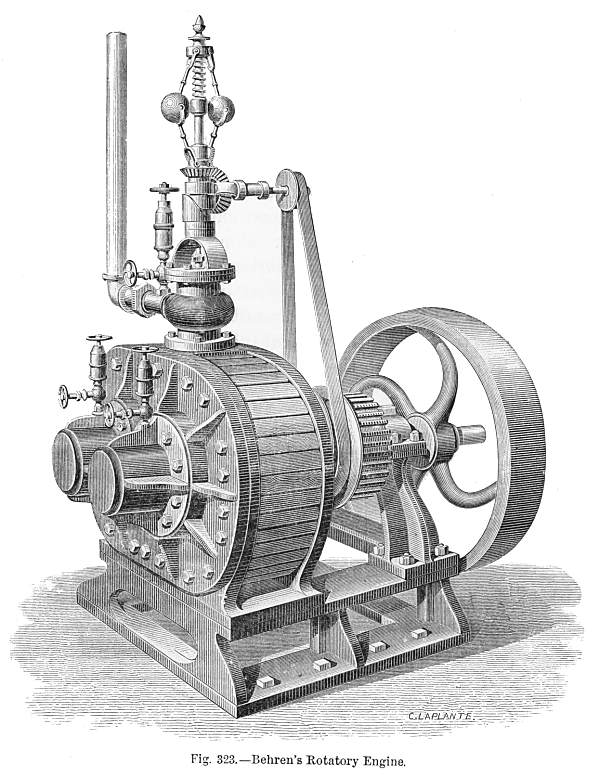
There is a possibility that Rowe’s first Steam Man is the same or similar to Morrison’s Steam Man, and may be linked to Prof. George Moore’s Steam Man..
The video clip below shows the “Autoperipatetikos” doll in motion. Note that only one of its legs appears to be operational.
Morrison’s patent for “Autoperipatetikos” – (Walking Doll)
IMPROVEMENT IN AUTOMATIC APPARATUS FOR WALKING FIGURES – ENOCH R.. MORRISON
Patent number: 35886
Issue date: 1862
See full patent document here.
Morrison’s 1861 patent for “Locomotive Apparatus” . Notice it was assigned to the Hanlon Brothers, who get mentioned in the Scientific Americal article on this Steam Man. It has been generally acknowledged that the “Autoperipatetikos” walking doll was the first walking toy, but if the Hanlon Brothers did produce toys based on Morrison’s design, Morrison may still have the recognition of having the first patented toy walking mechanism, but realised on his earlier patent, not the later “Autoperipatetikos” patent.
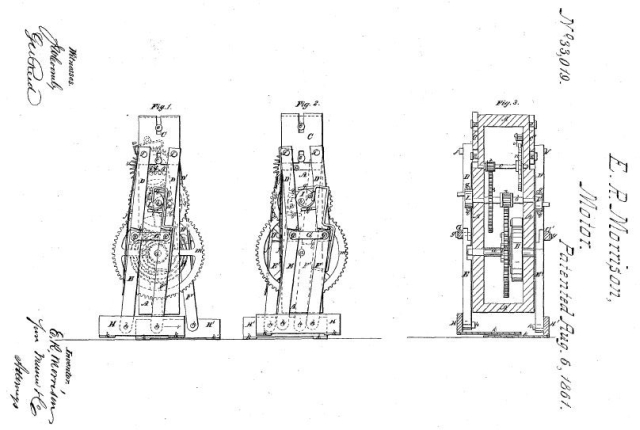
Inventor: E. K. MOKEISON [Google OCR error – should be “Enoch Rice Morrison”]
Assignee: THE HANLON BROTHERS
Patent number: 33019
Issue date: Aug 6, 1861
Enoch Rice Morrison was residing in South Bergen , New Jersey at this time.
See full patent document here.
Note: 30 July 2010. Both the above patents have not appeared on the internet before. They are not found under the normal search criteria using Google patent search, either, and are the results of many tens of hours of indivdual patent searching, such is what I do for some of my researched postings. Enjoy!